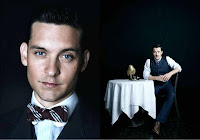 As I’m sure you all would have heard by now, Baz Luhrmann’s Great Gatsby will have its
As I’m sure you all would have heard by now, Baz Luhrmann’s Great Gatsby will have its  Fitzgerald’s literary classic. If you haven’t read the book I highly recommend you do so (preferably before the movie version is released). It is very easy to read, highly entertaining and I promise you that you will fall in love with Gatsby’s devotion to the undeserving Daisy Buchanan- one of the most selfish heroines ever created in the history of literature (my sole opinion of course)!
Fitzgerald’s literary classic. If you haven’t read the book I highly recommend you do so (preferably before the movie version is released). It is very easy to read, highly entertaining and I promise you that you will fall in love with Gatsby’s devotion to the undeserving Daisy Buchanan- one of the most selfish heroines ever created in the history of literature (my sole opinion of course)!  However, as great as the book is I do not want to discuss its literary merits; I am far more interested in the buzz the movie is creating in the fashion world. This month, the cast of the movie have appeared in numerous fashion magazines (Carey Mulligan in Vogue USA, Leonardo Dicaprio in Esquire and the whole cast in Vogue Australia) who have taken the fashion of the film and combined it with the 1920’s era of glitz, glamour and jazz. Some photos from the shoots are attached throughout the post.
However, as great as the book is I do not want to discuss its literary merits; I am far more interested in the buzz the movie is creating in the fashion world. This month, the cast of the movie have appeared in numerous fashion magazines (Carey Mulligan in Vogue USA, Leonardo Dicaprio in Esquire and the whole cast in Vogue Australia) who have taken the fashion of the film and combined it with the 1920’s era of glitz, glamour and jazz. Some photos from the shoots are attached throughout the post.  Catherine Martin, the film's costume designer, who incidentally happens to be Luhrmann’s wife, collaborated with Muccia Prada on costumes in the film. They created over 40 looks for the film inspired by archives from Miu Miu and Prada. The Brooks brothers worked with her on the men’s costumes. This does not come as a surprise as the brand was the go-to-place for men’s clothing in the 1920’s. Added to this Fitzgerald himself was a patron of the brand. And you will agree, I am sure, from the picture attached that they have done a fabulous job of bringing the 1920’s American gentlemen on screen.
Catherine Martin, the film's costume designer, who incidentally happens to be Luhrmann’s wife, collaborated with Muccia Prada on costumes in the film. They created over 40 looks for the film inspired by archives from Miu Miu and Prada. The Brooks brothers worked with her on the men’s costumes. This does not come as a surprise as the brand was the go-to-place for men’s clothing in the 1920’s. Added to this Fitzgerald himself was a patron of the brand. And you will agree, I am sure, from the picture attached that they have done a fabulous job of bringing the 1920’s American gentlemen on screen.
In addition to the fashion of the movie, the movie has also inspired high fashion and high street designers alike to bring the 1920’s back in vogue. Have a look around your favourite retail stores and you won’t be able to take two steps without seeing fringed dresses, 1920’s head bands or pearls. Given that Gatsby is a giant sartorial gift wrapped with Luhrmann magic, it is safe to say that I will be buying my ticket in advance to go see the first show!


















